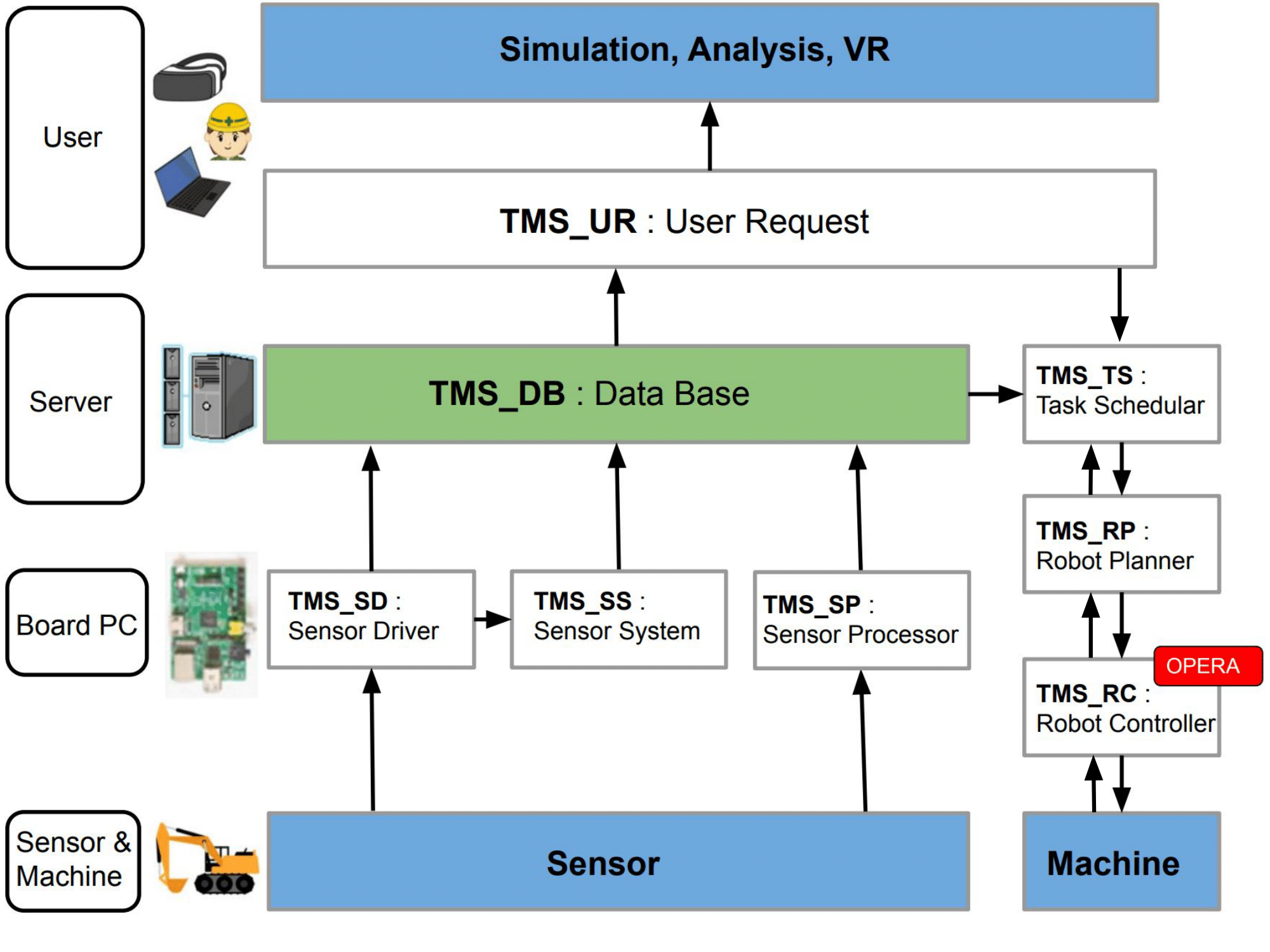ROS2-TMS-FOR-CONSTRUCTION is an IoRT (Internet of Robots and Things) library for construction applications developed based on ROS2-TMS.
ros2_tms_for_construction.mp4
ROS2-TMS is an IoRT (Internet of Robotic Things) library for TMS (Town Management System), which is the management system of an informationally structured environment (ISE). ROS2-TMS is designed on the basis of ROS-TMS and adopts the state-of-the-art robot middleware, ROS2. This system integrates various information collected by distributed sensors, stores it in an on-line database, plans appropriate service tasks, and manages and executes robot's motion.
Wiki page : https://github.com/irvs/ros2_tms/wiki/ROS2-TMS
ROS2-TMS was developed as a part of "MyIoT Store" in "MyIoT Project" supported by the Cabinet Office (CAO), Cross-ministerial Strategic Innovation Promotion Program (SIP), “An intelligent knowledge processing infrastructure, integrating physical and virtual domains” (funding agency: NEDO).
ROS2-TMS-FOR-CONSTRUCTION is newly developed as an IoRT library for construction applications based on ROS2-TMS with the support of JST Moonshot R&D, Grant Number JPMJPS2032 entitled “Collaborative AI robots for adaptation of diverse environments and innovation of infrastructure construction” in “Moonshot Goal 3: Realization of Artificial Intelligence (AI) robots that autonomously learn, adapt to their environment, evolve itself in intelligence, and act alongside human beings, by 2050.”
Project page: https://moonshot-cafe-project.org/en/
There are two ways to set up ROS2-TMS for Construction: by entering individual commands directly or by using scripts.
-
Using scripts.
cd mkdir -p ~/ros2-tms-for-construction_ws/src && cd ~/ros2-tms-for-construction_ws/src git clone https://github.com/irvs/ros2_tms_for_construction.git cd ros2_tms_for_construction . setup.sh
ROS2-TMS-FOR-CONSTRUCTION consists of the following packages. The details of each package are as follows:
-
ROS2-TMS database manager. This package has tms_db_reader(_gridfs) and tms_db_writer(_gridfs) nodes.
-
tms_sd_ground is a package for formatting OccupancyGrid msg to Tmsdb msg and sending it to tms_db_writer.
The received OccupancyGrid msg is a heatmap showing the hardness of the ground.
-
tms_sd_terrain is a package for handling point cloud data of static and dynamic terrain.
The received PointCloud2 msg is a point cloud data of terrain.
Static terrain refers to terrain that does not change during construction operations. And dynamic terrain refers to terrain that changes during construction work.
-
tms_sd_theta is a package for formatting CompressedImage msg to Tmsdb msg and sending it to tms_db_writer.
The received CompressedImage msg is the jpeg image taken by a 360-degree camera.
-
tms_sp_machine is a package for handling data realated to construction machines.
-
tms_sp_sensing is a package to update dynamic parameters stored in mongoDB based on ros topic sent from another pc.
-
tms_ss_terrain_static is a package for handling point cloud data of static terrain.
The received PointCloud2 msg is a point cloud data of terrain.
-
tms_tf_gui is a package for transforming construction data (ex. machine's location, terrain and hardness of ground) using GUI tools.
-
tms_ts_launch_ts is a package for specifying and executing tasks to run the actual construction machinery.
-
tms_ts_subtask is a package included in subtasks.
If you want to implement new subtasks, please refer programs in the tms_ts_subtask directory.
-
tms_ts_manager is a package that contains the main program of task schedular.
-
sensing_msgs is a package that contains .msg files for sensing process.
-
tms_ur_button_input is a package that searches data in mongodb for the corresponding task when the GUI button is pressed, and passes the corresponding task sequence to the task scheduler.
Here are some demonstrations. Before starting the demonstrations, each terminal must be set up with the following commands.
cd ~/ros2-tms-for-construction_ws
source install/setup.bash
- Store data
- Get stored data
- Store and get data simultaneously in real-time
- Try running the task schedular
- Try running the task schedular with OperaSim-PhysX
- Insert new task data to tms_db
- How to update parameters in mongodb based on topics from sensing pc
-
Date : 2022.8.19 (since 2022.8.19 ROS2-TMS-FOR-CONSTRUCTION / since 2019.2.14 ROS2-TMS / since 2012.5.1 ROS-TMS / since 2005.11.1 TMS)
-
Ubuntu 22.04 LTS 64BIT
-
ROS2 Humble Hawksbill : https://docs.ros.org/en/humble/Installation.html
-
mongodb 6.0
-
pymongo 4.3.3
-
open3d 0.16.0
-
numpy 1.22.3
-
catkin-pkg 0.5.2
-
empy 3.3.4
-
lark 1.1.3
-
setuptools 58.2.0
-
numpy-quaternion 2022.4.3
